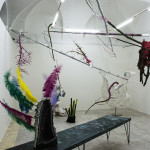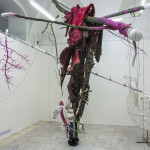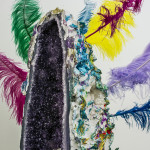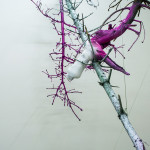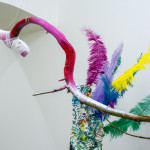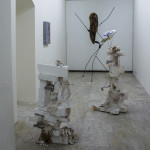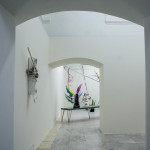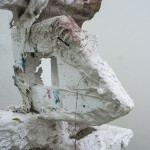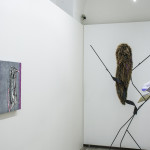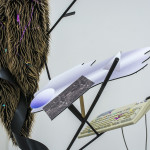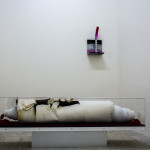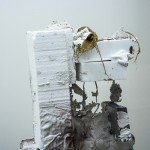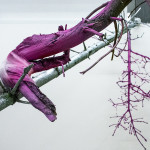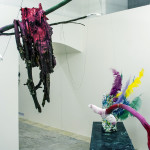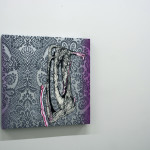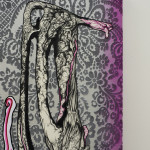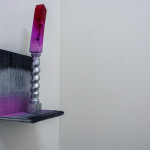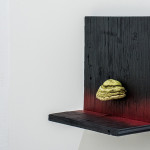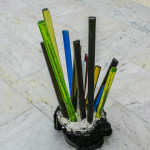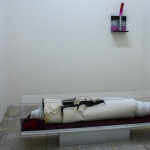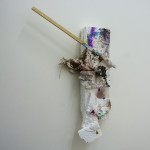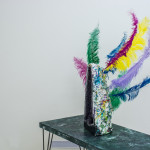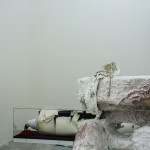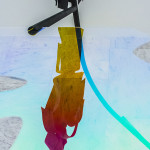Lumír Hladík and Matyáš Chochola at GAVU – museum of fine arts – city of Cheb, Czech Republic
Colours
Totalitarian Czechoslovakia jiggling incessantly on tender wavelets of shades of gray.
Primeval forests, shopping centers, the ocean, Costa Rica, Munich, gold mines in Ontario, a gallery in Chelsea, an aboriginal dump site and its proprietor, selling bear skulls, vistas of uncontrolled color explosions all the way from the almighty mammon’s usurpation of one’s attention via advertising politics of the world markets, to riotous variation of improbabilities on the wings of a passing flying bird.
Observing the black and white photographic (film is a rarity) documentation of the work of famous names of Czech action art in the late 70s; Kovanda, Štembera, Miller or Hladík, will give you an impression of a certain formal stability with a hint of inappropriate chaos.
Photographs of Jiří Kovanda opening his arms towards a stream of passing pedestrians on Wenceslas Square, Štembera measuring stairs, Lumír watching the Baltic Sea’s reflection in a mirror or his twenty minute vigil in front of a anonymous, closed door. The dichromatism in all those images is being disturbed by some colorful reflections passing through them.
The reality of the normalized (post-soviet invasion, reinstated communist) Czechoslovakia of the70s, from the perspective of my twenty-eight years, emerges as a conceptual model reconstructed from diverse channels of shared experience; the picture is far from clear and a disturbing one nevertheless. Despite frequent declarations that the activities of the unofficial group of Czech artists were apolitical in nature, it is apparent that their subtle, often deliberately invisible manifestations were, in some ways, reflections of everyday banality. Italian theorist Franco Berardi admits that it is quite difficult to define art, however, we can get around it by using a simple statement that defines an artist as a person, who’s perception of “things” around him/her subtly deviates from the one shared by rest of the society. It is this very deviation that relates and explains the colour we can observe on the black and white photographs produced by the action artists of the post-soviet invasion era: a tiny seed of seemingly controlled chaos within otherwise solid barriers.
Today, when Lumír grabs a dry branch in the forest, dresses it up with gauze and sprays
it with pink and silver colour or inserts a drawing of a dead tree bark into a deerskin, we may, from at a first glance perspective and by juxtaposing it to his 70s work, reflect on it
in terms of some oversized, simplified post-conceptual theatricality, overindulgence and stylization. His “Bear’s art”, as I call it, is created in a natural interaction with minimally regulated nature of Canada’s national parks. Lumír places objects in the woods, in a spot teaming with wildlife, not only enticing its intervention but also exposing it to the process of natural entropy. The object usually consists of carefully selected and intermingled artifacts originating from various contexts. After some time, Lumír removes the object from the woods and enhances it using additional elements. How far removed is this sorting-out-of-time-memes and the process around it from the action art, to which Lumír had been devoted in then Czechoslovakia? For example… from the creation of a geometric map of single elements in an unplowed field, positioned 10m apart, which he created together with Jiří Kovanda?
Materiality
Allegedly, we live in the time of the so-called “new materiality”; at least the art world is swinging and undulating on it for some time. A categorization of what is current is always problematic. Perhaps, with hindsight, we will view these tendencies of return-to-the-matter vehemently connected to the “Post-internet” phenomenon more objectively. Today, we do not even know what these terms actually mean, we just endlessly regurgitate them, we are publishing series of essays about them and organize conferences in order to, after reading it all, eventually, end up this quest with the initial essential question. We are simply voluntarily enslaved by our tendency to define and categorize matters within cages of our own definitions, content of which is too volatile to begin with and to be captured by a formula.
The search for eternity and spirituality of any new age is an old topic. For each generation, however, this redefining process becomes an inevitable necessity. Matyáš reads Franzen’s Golden Bough, reflects on cyclical time and animism: the same way as all the generations before him, again and again. Does any repetition, however, depreciate any current effort?
Matyáš is a typical Post-Internet artist.
“I am fed up with all those post-internets”, he claims. Post-Internets… venetian stucco, artificial marble, gold palm trees and blurred TV reception – all this truly repulsive in their shapes and noises, in addition to a tribal dance in the background.
So what do all these texts say about the current direction of art making? Post-Internet is not something after the end of the Internet, but it’s beginning, and, what’s more important, after its expansion. We live now with a very specific everyday experience of mail on our phones, with Facebook, Twitter and instant burgers dressed with double-lime mayonnaise: home made, of course. Our perceptions have radically changed through overabundance of information and its untamable streams.
But this does not explain the artificial marble, iridescent reflective surfaces, the amethyst geode with feathers or scribbles on a dibond surface. Matyáš is a typical Post-Internet artist and, as such, of course, rejects the notion of Post-Internet. We should all do the same.
We should wait.
Just as anyone else, Matyáš is not a Post-Internet artist.
There is no Post-Internet. There is only Matyáš.
Times.
Again, Jiří Kovanda is being discussed, what was then, what is today. Great topic.
Kovanda has shifted from his subtle actions to discreet installations, which we all love and people on the outside looking at them repeat the same ignorant eternal question: “and this is art”? So they are told, in a shortsighted manner, that this gentleman is ranked in the top of some bank indexes of the greatest living Czech artists and, people, again, are shaking their heads and knocking them against the wall.
We found branches, but made sure the entire thing would not turn out too natural, found Styrofoam, but beware, not let it be too Styrofoam. Colours, pink and silver, what Lumír likes, everything else what Matyáš likes. We are creating compositions via comprehensive alchemical instructions on how to do something that is not too different and vice versa. We are composing via precisely disdainful messiness. Three days spent in the woods gave birth to new art, which, otherwise, we would had to wait for a long time to come. We included a mix of art pieces from Prague and Toronto.
Behold, here it is, an exhibition in Cheb.
Jen Kratochvíl
Lumír Hladík belonged to the late 70s to the narrow circle of Czech action art and body art, along with Peter Štembera, Jan Mlčoch, Karel Miler or Jiří Kovanda, which he was closest to. Since 1981 he lives in Toronto, Canada.
Matyáš Chochola finished his studies this year in the studio of Vladimír Skrepl and Jiří Kovanda at the Academy of Fine Arts in Prague. He belongs to the most outstanding contemporary young artists, which was appreciated by the jury of the city of Zlín’s Salon of Young artists by awarding him the Prize of Václav Chad (2012).
Lumír Hladík, Matyáš Chochola
Small Gallery, 22. 1. 2015 – 22. 3. 2015
Curator: Jen Kratochvil

